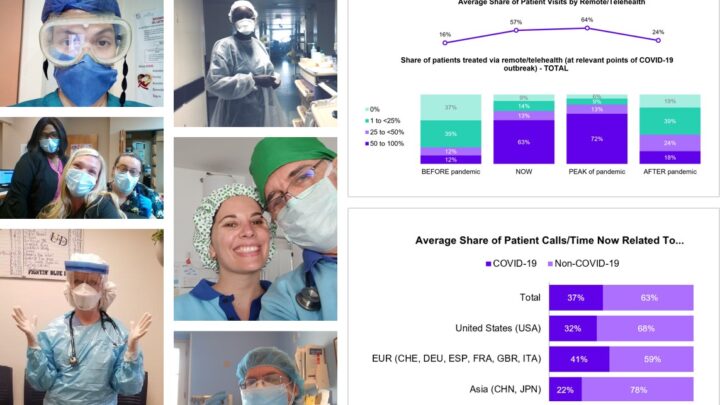
Telehealth is not a concept of the future and in 2025 represents a significant shift in patient care delivery. As digital technology continues to grow, both patients and providers find themselves embracing a telehealth mindset, not just a stop-gap measure for a worldwide pandemic.
One general practitioner on Sermo said, “Telemedicine: Undoubtedly, it has gained momentum every day, especially after the recent COVID-19 pandemic, allowing doctors to carry out consultations remotely, this not only improves access to care, especially in rural or underserved areas, but also offers convenience to patients, reducing the need for travel.”
Enhanced access, cost savings, and quality of care improvements make such technologies a requirement for today’s medical landscape. For physicians, telehealth increases efficiencies, provides better work-life balance, and attracts diverse patient demographics. A Sermo poll shows that 47% of its respondents offer telehealth services to patients and 42% are satisfied with its integration. Another general practitioner supported the use of telemedicine, saying “[…] we can mention advances such as artificial intelligence, big data analysis, telemedicine and innovative medical devices. We can talk about the benefits of these technologies, such as improved diagnostic accuracy, access to remote medical care and personalization of treatments, all of which address challenges to consider such as ethical and privacy aspects related to the use of technology in medicine.”
What is telemedicine and how has it evolved since 2020?
Telemedicine allows HCPs to provide services at a distance through telecommunications technology. This can be anything from video appointments to remote management of chronic conditions. However, while it had existed before, the push to make it more widespread really happened in 2020. With COVID-19 lockdowns and suggestions of social distancing, many hospitals and healthcare facilities had to rapidly shift to at-a-distance care. Institutions and legislations quickly bonded to ease the process of implementing virtual healthcare.
For doctors surveyed worldwide on Sermo, 2020 was a telehealth “before and after.” For some physicians, telemedicine allowed them to treat their patients with sinusitis, urinary tract infections, and mental health concerns without bringing them into the office, but that didn’t stop them from being treated. An internal medicine physician stated, “I consider this topic to be very interesting. It is true that telehealth is widely used today and much more so after what happened during the COVID 19 pandemic. Through its use, for example, we can provide general medical care, such as wellness visits, prescriptions for medications, skin care, nutrition advice, mental health advice, providing care for some conditions such as sinusitis, urinary infections, feverish symptoms, etc.”
New technologies such as artificial intelligence, wearables, and mobile applications provide more detailed access to virtual medicine than ever. Remote diagnosis can be done quickly, and treatment patterns indicate more specified paths of action due to documentation from previous visits. A general practitioner on Sermo said, “It is essential to be able to provide medical care through this tool, which undoubtedly had a before and after with the appearance of the COVID pandemic, and technological advancement.”
As telemedicine has emerged in the modern world, many advantages abound for physicians who choose to practice this innovative form of medicine. A nephrologist said, “Currently, telemedicine is an option that arrived since the time of COVID 19 and is here to stay. It has been shown that it works although it has its limitations, giving a consultation through a screen or a telephone will never be the same as doing a physical examination.” Regardless, the benefits may outweigh the limitations for many patients and providers.
Benefits of telemedicine for physicians
The emergence of telemedicine has several benefits for physicians, detailed below are the top 10:
1. Flexible scheduling
Practicing telemedicine allows physicians to more easily accommodate their schedule. Without needing to travel to an office or maintain set clinic hours, practitioners can structure virtual appointments around other personal or professional activities. Such newfound ability to schedule increases professional satisfaction and makes day-to-day life much more enjoyable.
2. Less administrative burden
Paperwork linked to on-site visits is reduced thanks to digital workflows. From scheduling to prescription to charts, the busy work occurs digitally and is expanded while treatment can be rendered.
3. Lower overhead expenses
Digital practices require less square footage, lower operating expenses, and no on-site staff, as many expenses that keep doctors afloat are not needed. Lower expenses mean more funds available for allocation for treatment technology for patients or passing the savings onto patients.
4. Less no-shows
No-shows are less frequent with virtual visits since patients need not travel to a doctor’s office to see a physician. This means better continuity of care and less financial loss associated with absent appointments.
5. Easier patient continuity of care
Digital applications make it simple to stay in touch with patients regarding their diagnosis and treatment at every stage. Virtual appointments can include follow-up care, prescriptions, check-ins and refills, and surgical check-ins to help with longitudinal effectiveness.
6. Lower risk of disease transmission
Less exposure to contagious viruses is a benefit of virtual appointments. Whether it’s cold and flu season or another pandemic, staying away from doctor’s offices can keep both providers and patients healthy.
7. Increased productivity
Many telehealth solutions have integrated features that make processing patients easier. From built-in appointment reminders to AI-led patient triaging and data processing applications, a telehealth solution can boost practice productivity and allow you to see more patients without compromising care.
8. Better work-life balance
Flexible hours and reduced stress enhance doctors’ work-life quality. With the burgeoning physician burnout epidemic, telemedicine provides access to a more advantageous work environment.
9. Better communication between medical practitioners
Whether patients require referrals for specialists or additional treatments, it’s easier for general practitioners, specialists, and allied health professionals to connect via the online setting and allow for global collaboration. General practitioners and specialists alike have access to the same patient records with simple vetting and referral for comprehensive and adjunctive care. In fact, a general practitioner from Spain said, “It is definitely the future. In my place of work we are very accustomed to telehealth and it is clearly having great results and improving the attention of some of our patients. Even more we have a telecommunication program between doctors for the primary healthcare workers who are closer to the patient to ask doubts to the other specialists.”
10. More avenues for revenue
Telemedicine expands a doctor’s patient base, as those out of the geographical range or patients who are more inclined to no-show due to access issues can be seen remotely. There is also a part-time opportunity for many doctors who work on telehealth platforms to lend their expertise for added income.
Advantages of telemedicine for patients
Of course, patients also have many advantages when using telehealth services. Here are some of the top reasons more patients are turning to virtual wellness:
1. Convenience and accessibility
Possibly the most convincing advantage of telemedicine is convenience. Patients can speak with their doctors from home, their office, or even while on vacation, receiving care without the concern of physical ailments or those living in remote areas. A family medicine doctor on Sermo said, “Telehealth has several advantages, including cost savings, convenience, and the ability to provide care to people with mobility limitations, or those in rural areas who don’t have access to a local doctor or clinic.”
2. No travel time or costs
Traveling to a medical facility requires time, money and even potential accommodation when seeing a specialist. Telemedicine provides a way to avoid such hassles and make healthcare accessible and less expensive for all, especially those in rural communities.
3. Faster access to physicians
With no physical logistics to get in the way, patients often receive diagnoses and treatment plans faster with shorter wait times. For those needing non-emergency urgent care, this can be a game-changer.
4. Better management of chronic conditions
With remote monitoring and check-in applications, patients better manage diabetes, high blood pressure, and respiratory issues. Patients are engaged in their care and can seek medical advice sooner rather than later.
5. More availability for appointments
With doctors able to see more patients via virtual appointments, availability is easier to come by. Same-day or next-day appointments are more readily available as doctors are on tighter schedules without a lull time in transition to waiting rooms.
6. Greater access to mental health counseling and treatment
From teletherapy to remote psychiatrist meetings, one-on-one private treatment sessions have less stigma and better access for those who might be hesitant to get treatment. When sessions are easily accessible in private and without the concern of an in-person hassle, more people utilize them.
7. Less risk of exposure to infection
As physicians benefit from reduced transmission, so do patients. For patients with weakened immune systems such as the elderly or pregnant persons, there are fewer opportunities to contract illnesses from germs and pathogens spread by others.
8. Easier access to specialists
Patients don’t have to travel extensive distances to meet with specialists. This is especially true of oncology, dermatology, and neurology, where telemedicine has facilitated the dissolution of geographical barriers.
9. Follow-up/care convenience
For post-operation follow-ups or for conversations that need to be had down the line, secure video conferencing makes treatment convenient, and may also result in cost savings for the patient.
10. Minimized wait time for appointments
Less waiting time equals better patient satisfaction. Especially with specialist fields in high demand, this helps relieve the patient burden in some cases, so that waiting isn’t as tedious and treatment can begin sooner.
Why the telemedicine trend matters in 2025 and beyond
Telemedicine is no longer a fad but a requirement as medicine develops and patients increasingly want technological integration, particularly as 87% of Sermo poll respondents believe that telehealth usage will continue in the future.
Telemedicine changes the quality of care for the better, makes physicians more satisfied, and is a required mode of access that kept patients from previously getting proper care. Physicians must remain proactive, educated, and share their experiences about this new mode of healthcare acquisition and implementation to regularly change how people approach health. Sermo is that community, for physicians to share and learn from one another, to help others beat the clock and transform medicine sooner rather than later.















